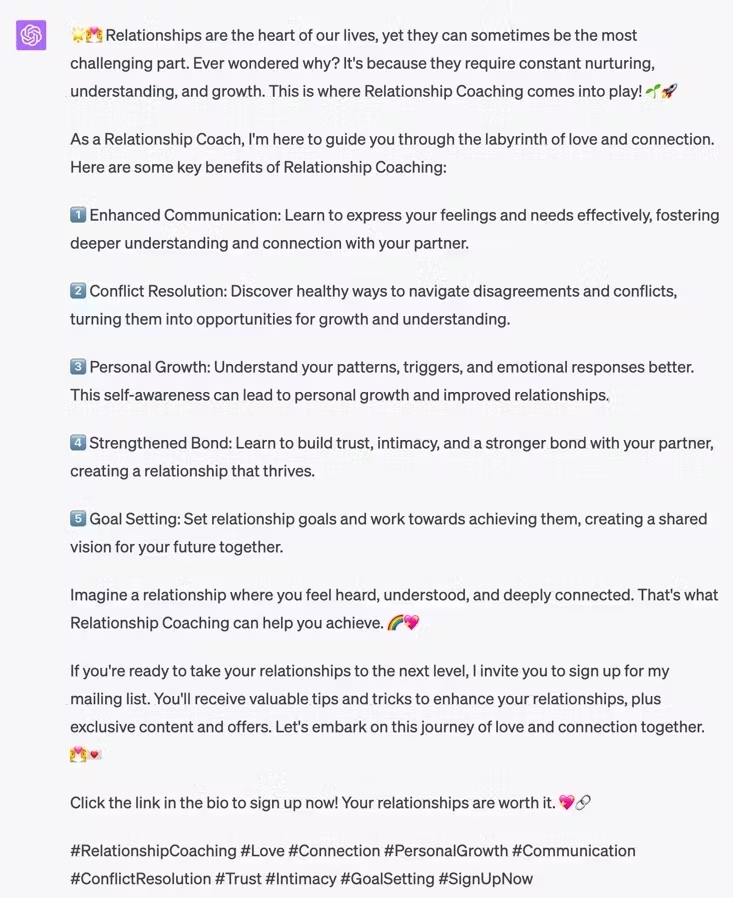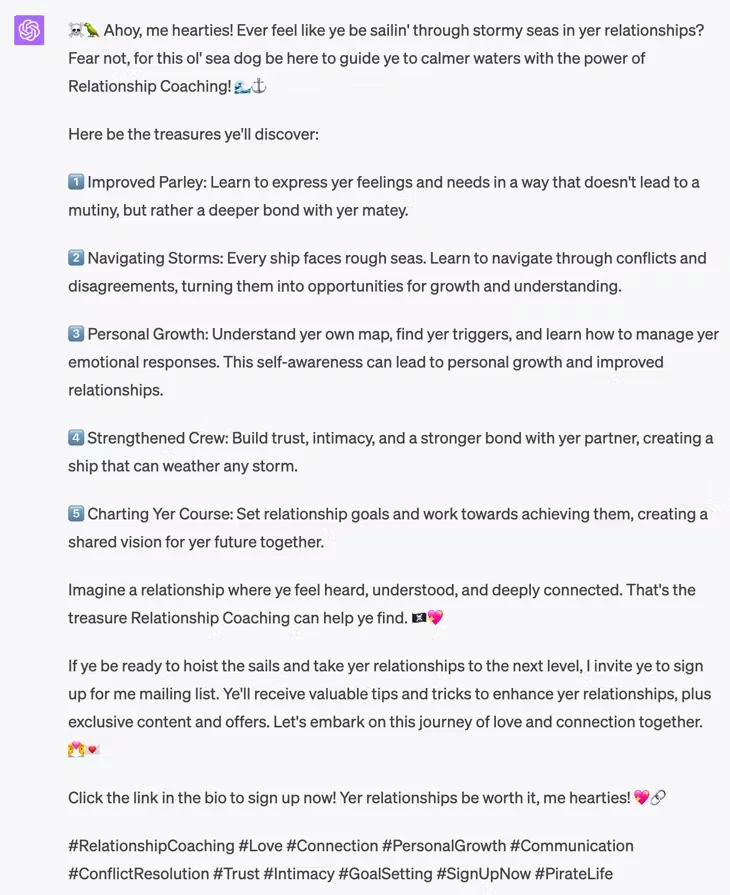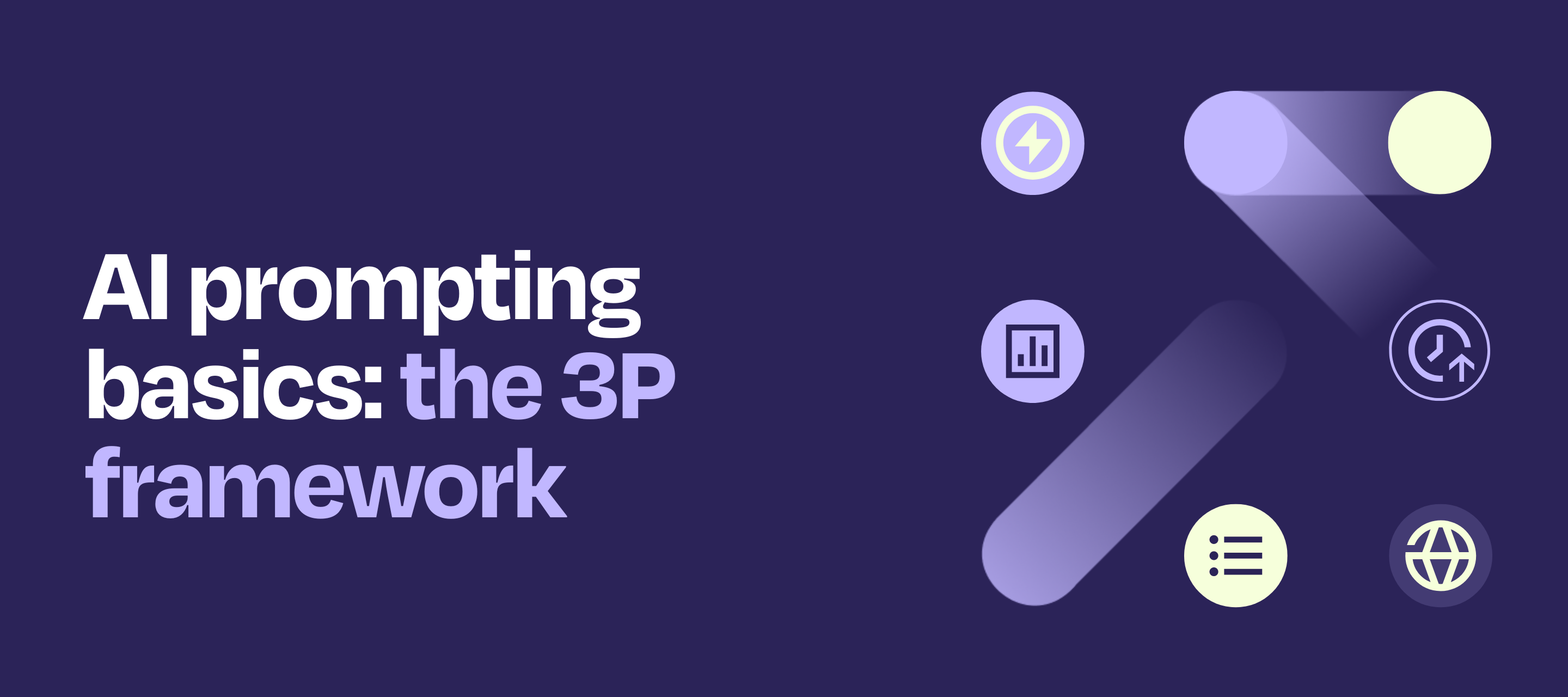Introduction
Prompting is just another word for making a request and it's one of the most common ways to interact with AI. It's a skillset. One that can save you a lot of time and inspire new ideas if you know how to use it.
It turns out, with any great relationship, artificial or not, the communication piece is key. What you say and how you say it will determine the quality of the response you get back. Remember, your inputs create your outputs.
This comprehensive guide will walk you through the core components of prompting and time-saving tips and tricks along the way. I've personally read and purchased all of the most popular prompting guides currently available and I am summarizing and simplifying the most common approaches and foundational components for you here.
Let's dive in!
The Core Components
I like to think of prompting in a trifecta of "P's". In order to write a good Prompt, you must include Purpose and Parameters and define the final Product.
Purpose
You "purpose" is about telling AI what you want it to do and why. We can get great responses back from sending over a single prompt, but including more information of why you're requesting this and what it is you're hoping to do, helps the AI be more intentional and specific with how it responds. Let's get more specific.
What
We're going to take it back to elementary school English for a moment as this generally includes a VERB followed by a NOUN. Remember those? A verb is an action word and a noun refers to a "person", "place", or most common in this scenario, a "thing". A prompt at it's most basic level includes these two things.
Here are some examples:
- List common pain points of [niche]
- Write an Email
- Generate a Headline
Now, when it comes to the "Noun" piece, you can either first give already-written content to the AI or you can ask it to write content for you.
For example, you could keep things simple and prompt it to "write an email" or you can provide additional information by pasting in an email you wrote and asking it to "shorten" or "expand" on this email.
You can call out specific platforms as well. For example, instead of asking AI to "write a social media post" you can tell it to "write a LinkedIn post".
If you do ask the AI to write content, this should be for inspiration/brainstorming purposes only. Fully AI-generated content is likely to get picked up by search engines as spam. Plus, it lacks your own unique perspective and tone, which is generally necessary to have engaging content.
Why
Next, we need to state our goal. This is kind of like the purpose of the purpose of your prompt. Why are you asking the AI to do this? What is the result you're after?
Here are some examples:
- Engage my audience
- Showcase the key benefits of relationship coaching
- Drive brand awareness
- Increase clicks to my CTA
- Encourage my audience to sign up for my email list
- Increase traffic to my website/landing page
If we combined an example from the "what" list and the "why" list, our prompt could look something like: "Generate a Headline to increase traffic to my website" or "Write an Email to engage my audience". Now, the response you get back will be more tailored to the intent.
Parameters
Now, this is where we can get really creative in our prompting. We can drastically change the results we get from the AI when we use parameters. You can preface your prompt with them, include them in the end, place them in the beginning, or use all of those placements at once, if necessary! Here are some of my favorites to get you started:
Type
This is an expansion on the "what" from the previous section and it's a way to get even more specific on the type of content you're asking to be created. For example, your "what" can be a "blog post" but you might want to specify the type of blog post. For example, "Write a case study blog post" or "Write a recap blog post of the [event]". Defining the type will help the AI understand how to approach this and which sections to include/leave out.
Character/Profession
We can tell the AI to first act as a (character) when writing a prompt. To pull from the examples above, I can say something like:
"Act as a life coach and generate a Facebook post that showcases the key benefits of relationship coaching, including a CTA to sign up for my mailing list to get more tips and tricks for how to enhance their relationships"
Which results in this response:

If I changed the beginning to "Act as a Pirate", my result would be quite different (and quite humorous!).

Another way to use this parameter is by telling the AI to act as an expert on a particular topic. So, using the example above, I can edit the beginning of my prompt to read:
"Act as a life coach who is an expert in conflict resolution and the Gottman methods."
That will give the post a bit more of a specific focus.
Tone of Voice
We can preface or end our prompt with a tone of voice we want the response to be generated in. Do you want to sound professional? Confident? Casual? Empathetic? Inquisitive? Authoritative? Sincere? You get to decide (and you can choose more than 1!)
Audience
You know how to tell the AI who to act as but you can also tell the AI who you want it to talk to! Including information about your target audience is a great way to get even more specific. You can say this to the AI at any time but I tend to tell it right in the beginning. This is my method:
"Audience: Capable life coaches who feel overwhelmed by technology. Specifically, software and automation."
And then I carry on with the rest of my prompt:
“Write an email that educates and engages the audience on the topic of automation, in a way that is confident yet empathetic to their struggles.”
Product
An important thing to keep in mind here is that when you are prompting, you are not only learning how to best make your request, but you are also telling the AI the format you'd like your answer in. We need to be just as clear here as when we are making the request to gain more control over what our final product looks like.
Format
If you've played around with AI and learned prompting from trial and error, you've likely made the mistake of not specifying the format of how you'd like your answer returned in. So, for example, if you ask AI to summarize something but do not give it any rules on how you'd like the summary, it will do whatever it likes, potentially costing you more tokens than you were hoping to spend.
To get around this, you can ask it to reduce or expand your content to a certain length, request the response in paragraphs, tables, bulleted/numbered lists, stay within certain character counts, respect different style formats, etc.
Style
Respond in the style of:... (choose your favorite thought leaders, characters, heroes!) For example, you can ask AI to respond using different styles of communication like Seth Godin, Michelle Obama, Tony Robbins, etc. You can even combine multiple communication styles together.
Conclusion
By understanding the core components of prompting—Purpose, Parameters, and Product—you can drastically improve the quality of your content, streamline your workflow and generate new ideas. To recap, that means:
- Clearly defining the purpose of your request, including the specific action you want and why you want it, allows the AI to respond more effectively.
- Incorporating parameters tailors the output to your specific needs.
- Defining the final product ensures you receive an output that matches your desired format and style.
Mastering the art of prompting not only ensures you receive high-quality responses but also helps you develop a better relationship with AI. So, the next time you're prompting, remember these guiding principles to unlock its full potential.




